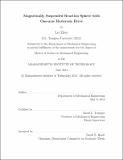Magnetically suspended reaction sphere with one-axis hysteresis drive
Author(s)
Zhou, Lei., Ph.D. Massachusetts Institute of Technology
DownloadFull printable version (12.29Mb)
Other Contributors
Massachusetts Institute of Technology. Department of Mechanical Engineering.
Advisor
David L. Trumper.
Terms of use
Metadata
Show full item recordAbstract
This thesis presents the design, modeling, implementation, and control of a magnetically suspended reaction sphere with one-axis hysteresis drive (1D-MSRS). The goal of this project is two fold: (a) exploring the design for a reaction sphere in 3D for spacecraft's attitude control, and (b) studying the performance of the hysteresis motor in reaction wheel applications. The 1D-MSRS is a motor with a spherical rotor with its rotor magnetically suspended in all translational directions, and is driven about the vertical axis by hysteresis drive. The magnetic suspension of the sphere is realized by arranging one electromagnet on top of the sphere, and a bearingless motor on the equator of the sphere. In this thesis, a complete mathematical model for the sphere's magnetic suspension, in both vertical and lateral directions, is derived. There is a good match between the calculated and measured system dynamics, which verified our modeling. The feedback control for the sphere's magnetic suspension in all translation degrees of freedom are studied in this thesis as well. The hysteresis drive is chosen for the 1D-MSRS because its advantages of simple structure, moderate self-starting toque, and vibration-free operation. The hysteresis motor in 1D-MSRS consists of a conventional stator arranged on the sphere's equator and a spherical rotor of magnetically hard steel. In this thesis, an equivalent circuit model of the hysteresis motor based on an elliptical hysteresis model is used to analyze the motor's dynamic behavior. Good agreement between computed and measured sphere speed data validated the motor model. Experimental data shows that a starting torque of 8.15 mNm is achieved at 0.7 A peak excitation current. Under this excitation, the sphere arrives synchronous speed of 1,800 rpm within 6 s. The sphere can reach 12,000 rpm in lab, with the existence of air drag. In order to suppress the hunting dynamics of the hysteresis motor, a feedback control loop on the sphere's rotational speed is implemented on the 1D-MSRS. A control scheme is designed for this nonlinear system, and its effectiveness is validated by both simulation and experiment. Through this speed feedback control, the 1D-MSRS can reach a minimum speed rise time while satisfying the constraints on its excitation amplitude, showing lower power consumption during steady state, and the hunting dynamics of the motor are effectively suppressed. As a result, when the motor is operating in steady state with a speed of 1,800 rpm, the power consumption of the 1D-MSRS hardware is 3.44 W. In this thesis, we also explored the design concepts for a magnetically suspended reaction sphere in 3D. A study of 3D spherical motors are presented in this thesis. We also demonstrated our understanding on the driving principle selection for spherical motors, and presented several magnetic design concepts for a 3D spherical motor design.
Description
Thesis: S.M., Massachusetts Institute of Technology, Department of Mechanical Engineering, 2014. This electronic version was submitted by the student author. The certified thesis is available in the Institute Archives and Special Collections. Cataloged from student-submitted PDF version of thesis. Includes bibliographical references (pages 187-190).
Date issued
2014Department
Massachusetts Institute of Technology. Department of Mechanical EngineeringPublisher
Massachusetts Institute of Technology
Keywords
Mechanical Engineering.